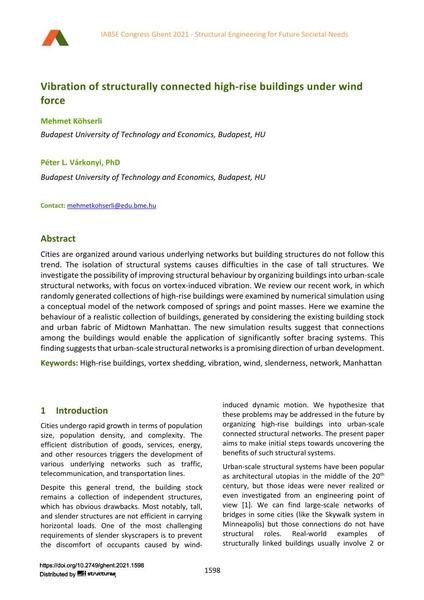Vibration of structurally connected high-rise buildings under wind force

|
|
|||||||||||
Détails bibliographiques
| Auteur(s): |
Mehmet Köhserli
(Budapest University of Technology and Economics, Budapest, HU)
Péter L. Várkonyi (Budapest University of Technology and Economics, Budapest, HU) |
||||
|---|---|---|---|---|---|
| Médium: | papier de conférence | ||||
| Langue(s): | anglais | ||||
| Conférence: | IABSE Congress: Structural Engineering for Future Societal Needs, Ghent, Belgium, 22-24 September 2021 | ||||
| Publié dans: | IABSE Congress Ghent 2021 | ||||
|
|||||
| Page(s): | 1598-1605 | ||||
| Nombre total de pages (du PDF): | 8 | ||||
| DOI: | 10.2749/ghent.2021.1598 | ||||
| Abstrait: |
Cities are organized around various underlying networks but building structures do not follow this trend. The isolation of structural systems causes difficulties in the case of tall structures. We investigate the possibility of improving structural behaviour by organizing buildings into urban-scale structural networks, with focus on vortex-induced vibration. We review our recent work, in which randomly generated collections of high-rise buildings were examined by numerical simulation using a conceptual model of the network composed of springs and point masses. Here we examine the behaviour of a realistic collection of buildings, generated by considering the existing building stock and urban fabric of Midtown Manhattan. The new simulation results suggest that connections among the buildings would enable the application of significantly softer bracing systems. This finding suggests that urban-scale structural networks is a promising direction of urban development. |
||||
| Mots-clé: |
vent bâtiments hauts
|
||||
| Copyright: | © 2021 International Association for Bridge and Structural Engineering (IABSE) | ||||
| License: | Cette oeuvre ne peut être utilisée sans la permission de l'auteur ou détenteur des droits. |
||||
